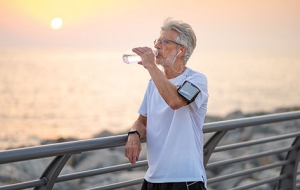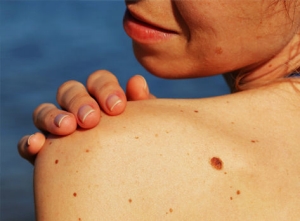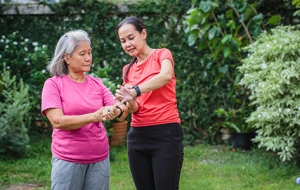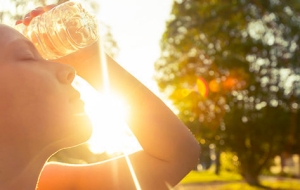
Summertime activities bring us out in the sun. Whether it’s time spent at the beach, pool, park, or garden, it’s important to protect your skin from the glare of ultraviolet (UV) rays -- and lower your risk of potential skin damage.
Here are a few simple steps you can take to enjoy fun in the sun without putting your skin in danger.
Sun Risks
According to the American Academy of Dermatology, exposure to UV light is the most preventable risk factor for all skin cancers. UV rays can reach you on sunny, hot days as well as on cloudy, cool days. Your body can absorb UV rays directly from the sun or reflected from surfaces such as water, cement, and sand. Sunburn is the most obvious sign of over exposure and skin damage, but even small amounts of UV radiation can have lasting effects for skin health.
Eric Whitman, MD, surgical oncologist, medical director of Atlantic Health System Cancer Care and director of the Atlantic Melanoma Center warns that people with sun-sensitive skin, blond, red, or light brown hair, those who have been treated for skin cancer, or those with a family member who has had skin cancer are most at risk.
“Because severe sunburns when you’re younger may increase the risk of skin cancer, children and individuals in their teenage years or 20’s should be especially protected from the sun,” he says. Dr. Whitman also stresses that everyone needs protection regardless of their age, skin tone, or inherent risk factors. Here are the reasons why.
- Skin cancer is the most common cancer in the United States, and it is estimated that one in five Americans will develop skin cancer in their lifetime
- More than two people die of skin cancer in the U.S. every hour
- Having five or more sunburns doubles your risk for melanoma
- Skin cancer warning signs include changes in size, shape, or color of a mole or other skin lesion, the appearance of a new growth on the skin, or a sore that doesn't heal
- When detected early, the five-year survival rate for melanoma is 99 percent
Your Best Protection
The most important rule for sun safety is to protect your skin by preventing UV rays from reaching it in the first place. If you are going to spend time in the sun, the Centers for Disease Control (CDC) recommends using sunscreen, covering up, and finding shade as a layer of protection from direct exposure.
Use Sunscreen
Using sunscreen is your first line of defense from UV rays. The American Cancer Society recommends choosing a sunscreen with broad-spectrum protection and a Sun Protection Factor (SPF) of 30 or higher. The FDA requires any sunscreen with an SPF below 15 to carry a warning that it only protects against sunburn, not skin cancer or skin aging.
Apply sunscreen generously. About one ounce of sunscreen (about a shot glass or palmful) should be used to cover the arms, legs, neck, and face of the average adult. Pay close attention to your ears and any other areas not covered by clothing. Lip balm with sunscreen is also available.
No sunscreens are waterproof or sweatproof, and therefore, the product must be liberally reapplied every two hours and more frequently after swimming or heavy activity. Kids are especially vulnerable because they are often in and out of water and cannot reapply sunscreen themselves. Check their coverage often to help them stay protected.
Cover Your Skin
Long-sleeved shirts, long pants and skirts, provide strong protection from UV rays. If the weather is very warm and heavier clothing is impractical, a T-shirt or a beach cover-up adds a layer of protection, but should be used with sunscreen on exposed skin for maximum coverage. The CDC notes that darker colored clothing offers greater protection than lighter colors. Clothes that are wet provide much less UV protection than dry clothes.
A hat with a wide brim and tightly woven fabric can protect your head, face, and ears from damage. As with clothing, a darker hat may offer more UV protection than a lighter one. Remember: a baseball hat only covers the top of your head and part of your face. Your ears and the back of your neck are exposed and should be protected with sunscreen.
Your eyes can also be damaged from exposure to UV rays, and the tender skin around your eyes needs protection as well. Sunglasses with dark lenses, especially those that wrap around the face, are ideal. According to the CDC, even the cheapest sunglasses offer adequate protection from the sun.
Find Shade
Limiting your time in the sun, especially between the hours of 10am and 2pm, when the sun’s rays are most intense, will reduce your exposure to UV rays. The National Weather Service and the Environmental Protection Agency have developed a UV Index to measure the intensity of sun exposure on a scale from 1 to 11+. A higher number means greater risk of exposure to UV rays and a higher chance of sunburn and skin damage that could ultimately lead to skin cancer.
Finding a cool, shady area to get relief from the sun is important, especially when the sun is most intense in the afternoon. Any covering will suffice -- an umbrella at the beach, a tree in the park or covered porch. The goal is to get out of the sun and to give your skin relief from UV rays.
Get Checked
According to Dr. Whitman, it’s important to examine your own skin for abnormalities and see a doctor if anything appears irregular.
“A good rule of thumb is to examine the moles on your body to see if any are abnormally shaped, itch, bleed, or change over time,” says Dr. Whitman. “If one looks very different from all the others, that's one you may want to show to your primary doctor or a dermatologist.”
Stay Safe
Finally, it’s important to remember that sun exposure adds up day after day, and it happens every time you are in the sun. But although sunlight is the main source of UV rays, you don’t have to avoid the sun completely. If you are careful and add layers of protection, you can enjoy yourself outside while preventing sun damage from occurring.
Be Proactive About Your Health
To stay safe and healthy, it's good to have a primary care provider who knows and understands your health history and wellness goals.
Related Articles
Your Healthy Summer Guide
Atlantic Health System is your healthy summer guide to a safe and fun season. From helpful tips to preventive and urgent care, we've got you covered for whatever summer brings.
5 Cool Tips to Prevent Heat-Related Illness
Learn 5 tips to help you stay cool and safe during hot and sticky summers and avoid heat-related illness.
How to Spot Melanoma: The Early Warning Signs of Skin Cancer
Melanoma is less common than other skin cancers, but it’s more dangerous if not treated early. Learn the early warning signs and how to spot melanoma.
Focus on Summer Heart Health
Even a healthy heart can be put under stress when temperatures climb. Learn more about what factors may make someone particularly vulnerable to heat-related conditions.
Avoid Heat Exhaustion this Summer
The summer heat and humidity sneak up on us. It is important to recognize the symptoms of heat exhaustion and heat stroke so you can protect yourself and those around you.




